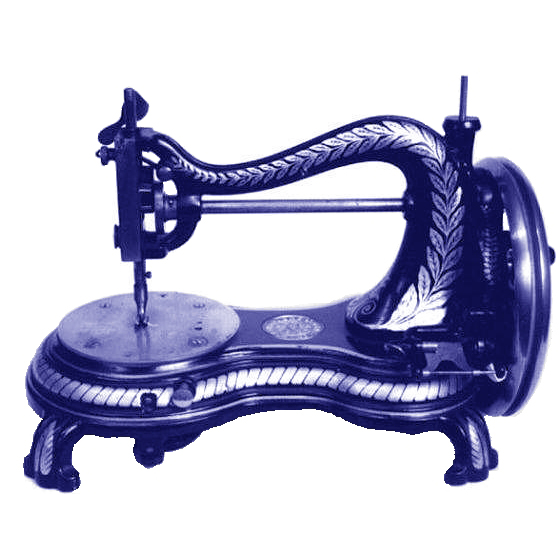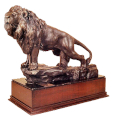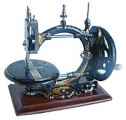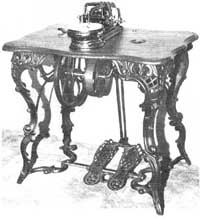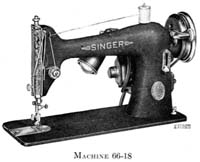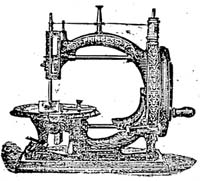Vulcan Toys
YOU'D THINK that a machine manufactured only 40 years ago would be relatively easy to research.
Not so in the case of the Vulcan toy company. In fact it appears that the manufacturer, despite producing a high-quality product deliberately tried to prevent anyone discovering its whereabouts.
Boxes with great 1950's graphics had everything except an address and even quality produced instruction manuals fail to give any clue to the maker's home base.
The only clue comes on an early instruction sheet with the name Cyldon Products
So lacking any background material to work from - not even a single advert, we will limit this article to thoughts about the machines themselves.
I've endeavoured to list them in chronological order - although to a large extent this is guess work. I'll give reasons for the guessing but input from members would be welcome.

My first suggestion is that the Singer 20 -style machine was the first produced shortly after the end of the second world war.
Although clearly borrowing from the Singer design, the machine is less of a blatant copy than some other examples of the mass cloning.
It differs from the Singer 20 set-up in that the boss for the tension assembly is built into the die-cast body of the machine.
Corners have been cut during construction. The top arm is held to its pivot by a crude drive pin rather than the screw on the Singer/Essex and the grub-screwed pin on Grains.
Two distinct types of the Vulcan "20" - my name - were produced. The first (another guess) had a solid hand wheel and a cast-iron base. Model two graduated to a spoked wheel on an aluminium base.
Both models had the rather crude fold at the front of the stitch plate designed (too strong a word that) to take the feed dog spring.
The transfer (decal) simply proclaimed Vulcan - Made in England. A word of warning here. This transfer is about the most delicate I've come across. Even the mildest cleaner will simply wipe it away. All models known are in bright blue.
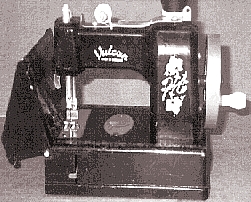
I'm putting the Featherweight next on the list as it uses the same mechanism of the "20". Again the chassis of the machine is die-cast aluminium but the extension to table - just like the Singer 221 in white/green - is sheet steel.
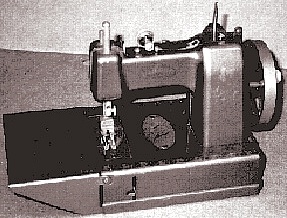
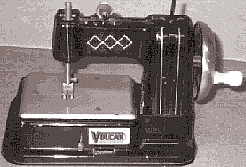
I've more doubts about where this one sits in the chain of machines. It has a painted stitch plate and zinc-coated needle and presser foot bars suggestive of immediately post-war production when chromium or nickel plating was severely restricted.
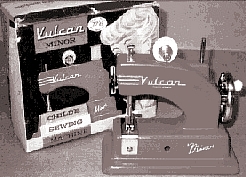
We now come to the Minor, Junior and Senior - first of the factory-named Vulcans and patented in 1957, the only definite date we have.
One handbook is used for all three so it's fairly safe to assume they were in production at the same time.
The quality of the casting is vastly improved with these models which had to names cast into the bodies.
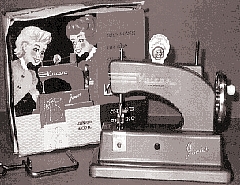
The Senior, was very up-market being essentially a free-arm machine and was originally sold with an extension table to turn it into a flat bed.
All three used the thin plastic washer behind the tensioner - a point to watch for is that this often goes missing or is broken.
It was at this time that Vulcan first used its sales line "For a lucky little lady".
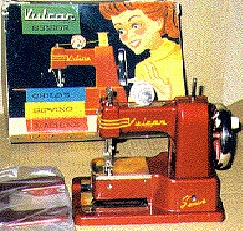
Box graphics on these models were great - pure 1950s - and one for a Minor in the MS collection shows a price of 27s 6d (1.37.5/$2.35). Seniors were maroon, juniors Two shades of blue one light, the other, much rarer, vivid blue and Minors came in bright red or salmon pink/orange colours.
It's likely that the Senior was dropped from the range first for a manual for the Classic and Countess still shows the Junior and Minor as available.
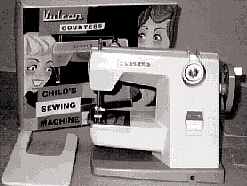
The Countess was certainly a more up-market machine than those which went before. It was a free-arm with extension table but the cast-in name had given way to a stick-on metallic label.
The Countess's sister, the Classic, was essentially the same machine but with a motor and battery power - Vulcan's first electric. Both used the reel as a tension device.
Countess and Classic machines were usually grey and green, grey and maroon or two-tone beige.

Next move by the company was to drop the Junior - another manual for the Classic and Countess lists only the Minor from the original trio and a further instruction sheets include mention of what I think was Vulcan's last model - The Regal.
This was also battery operated, featured the stick-on labels and the box came with up-dated graphics with no "Lucky Lady" to be seen.
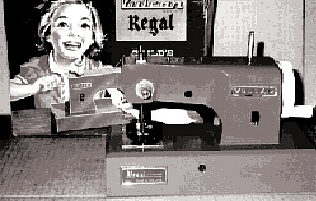
Certainly the Regal has little of the charm of its earlier sister and the quality of workmanship seems a tad short of its predecessors. Only known examples are in bright blue - which is where we came in.
Well, I've done my best to place the Vulcans in some sort of order. I know others may not agree so let's have some input here and kick the problem around a little.
Certainly the Vulcans - at least before the Regal - were well-made machines, far superior in detail and workmanship to the average machine of the 1950s and '69s.
They deserve their place in history - whenever it was.
